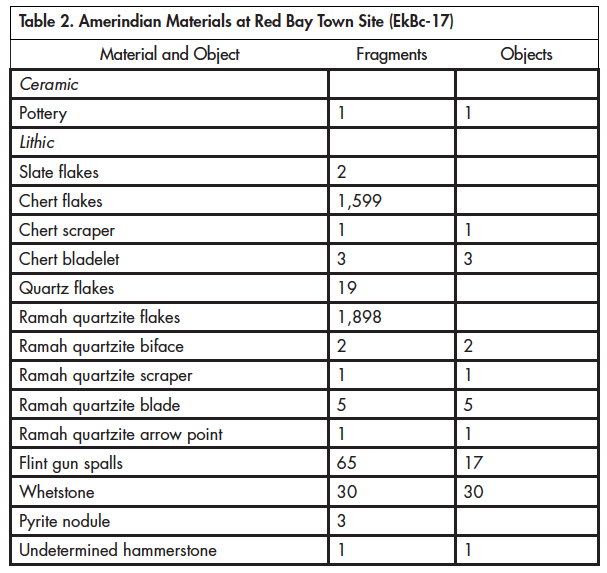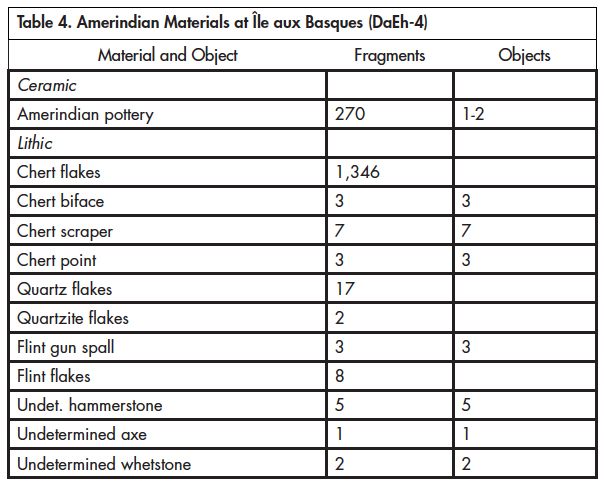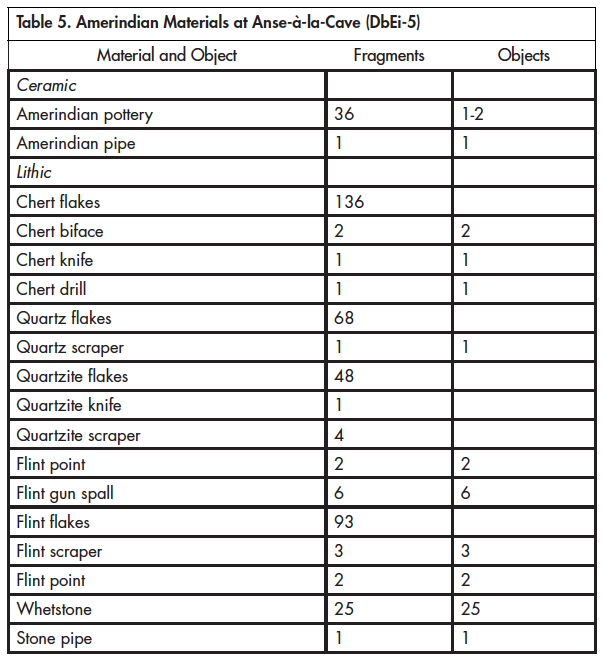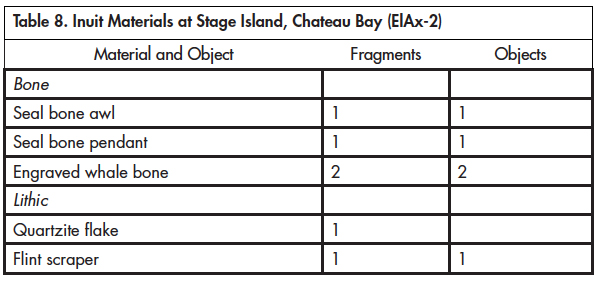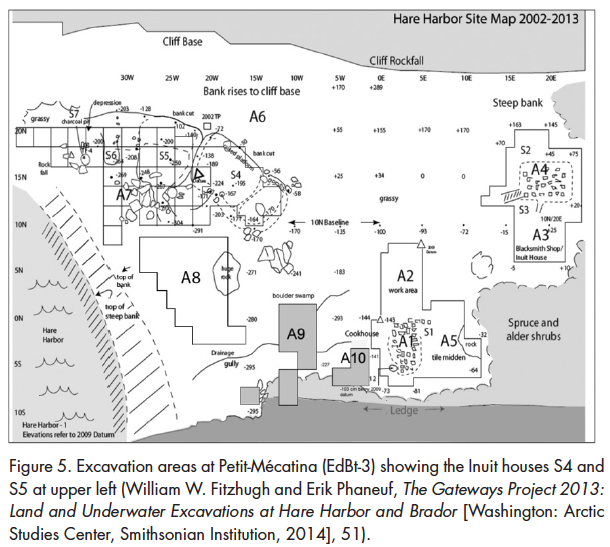Papers on the Basques in Newfoundland and Labrador in the Seventeenth Century
Indigenous Traces on Basque Sites:
Direct Contact or Later Reoccupation?
1 Archaeologists studying the contact period, especially in the region of the lower Great Lakes but also in the St. Lawrence Valley, have tended to assume a possible Basque origin for early European trade goods found in Indigenous contexts, such as glass beads, iron tools, and copper utensils (Trigger, 1976: 269; Fitzgerald, 1990: 9–10, 76, 547; Fitzgerald et al., 1993: 44; Turgeon, 1990; Bradley, 2007: 22–23; Moussette and Waselkov, 2013: 147–48, 160–63; Birch and Williamson, 2013: 147–49). While a recent review of trade beads suggested that Basques were not important suppliers of these objects often associated with European–Indigenous trade (Delmas, 2016), they may have transmitted iron tools and copper utensils to Indigenous peoples. Debate on possible contact between Basques and the local inhabitants carried into the study of Inuit, Iroquoian, and presumed Innu materials found during the excavation of Basque sites, from Labrador to the mouth of the Saguenay River. The archaeologists of these sites in the 1980s and 1990s regularly concluded that these contexts and materials could not be interpreted as signs of direct contact, based on stratigraphic uncertainty but also because simultaneous presence did not fit with the accepted dates of Basque occupations, Inuit presence in the Strait of Belle Isle, and Iroquoian “disappearance” from the St. Lawrence Valley. Also, as Brad Loewen has remarked, evidence of early contact between Indigenous peoples and Europeans sometimes became lost in “a no-man’s-land . . . reproduced by divisions between prehistoric and historical approaches in archaeology” (Loewen, 2016: 4–5). Since the 1990s, the accepted dates of Inuit, Iroquoian, and Basque cultural watersheds have been revised or questioned, allowing for a significantly wider “window” of possible contact. However, the archaeological data have not been reconsidered and, if fact, to our knowledge there has been no overall review of the evidence of Indigenous presence on Basque sites. Based on a review of field reports and collections, this paper’s goal is to briefly present the relevant data and summarize the archaeologists’ views at the time, and especially to analyze the archaeological instances that may indicate direct or close contact between Basques and Indigenous peoples.
2 The lack of clear archaeological support has not impeded historical research on relations between Basques and the local inhabitants. The ethnolinguist Peter Bakker mentions Basque relations with two Algonquian tribes — the Innu in southern Labrador and the lower North Shore, and the Mi’kmaq in Gaspésie and Nova Scotia (Bakker, 1989: 117). These long-standing relations led to linguistic borrowings and the creation and use of a rudimentary trade pidgin. Marc Lescarbot mentioned this language in 1609, as did Samuel de Champlain in 1611–13. The Basque-based pidgin was also mentioned in Acadia by the Jesuits Pierre Biard in 1616 and Paul Le Jeune in 1632–41 (Bakker, 1989: 120–26, 132–35). Bakker and collaborators show that the Basque-based pidgin was understood, used, and augmented by French fishers and traders in the seventeenth and eighteenth centuries. In 1694, Louis Jolliet explored the Labrador coast and met Inuit who hailed him in a pidgin that combined Basque, French, and Inuktitut (Bakker, 1996: 262, 272–73; Dorais, 1996: 311–16; Bakker and Johansen, 2005: 1–10). These linguistic data echo other records and archaeological findings showing that the Inuit advanced to southern Labrador and northern Newfoundland in the sixteenth century, where they maintained ambivalent relations with European fishers and traders until the eighteenth century (Stopp, 2002). Pope has documented a “guerrilla war” between Bretons and Inuit, while Stopp has suggested that archaeological data include much evidence of exchange, and Loewen has proposed phases of cordial relations between Basques and Inuit (Pope, 2015: 15–36; Stopp, 2002: 84–89; Loewen, 2017: 176–79; Castro, this volume).
3 The archaeologist Charles Martijn has suggested that the Basques had a “privileged partnership” with the St. Lawrence Iroquoians, who disappeared in the last quarter of the sixteenth century (Martijn, 1969, 1990). This sedentary population based between Lake Ontario and Quebec City was largely agricultural, although its most easterly members also sealed and fished in seasonal camps in the St. Lawrence Estuary as far east as Tadoussac and Gaspé (Plourde, 2012: 3–6). They even appear in the Strait of Belle Isle in 1542. Clemente de Odeliça, a Basque fisher from Hondarribia (Gipuzkoa), reported meeting a group from Kanata and their chief in Gran Baya (Martijn et al., 2003: 192–93).
4 Several Basque archaeological sites have yielded artifacts, and sometimes structures, indicating an Indigenous presence. We will present these findings and assess their temporal relationship with the Basque occupations, in order of their cultural affiliation with three Indigenous groups — Inuit, Innu, and Iroquoian — as seen by the archaeologists who excavated the sites from the 1970s to 1990s. Generally, researchers attributed an Amerindian affiliation to sites with ceramics and a range of lithic materials, and an Inuit affiliation to sites with winter houses and diagnostic bone and lithic artifacts. An Amerindian presence on Basque sites has been detected at Red Bay (EkBc-1, EkBc-16, EkBc-17), Blanc-Sablon (EiBg-9), Île Nue de Mingan (EbDa-6), and Île aux Basques (DaEh-4). Similarly, Inuit traces on Basque sites have been reported at Red Bay (EkBc-1, EkBc-5, EkBc-7, EkBc-12), Stage and Henley Islands in Labrador (ElAx-2, ElAx-3), and Petit-Mécatina on the lower North Shore (EdBt-3). We will present these data first for Amerindians, then for Inuit (Figure 1).
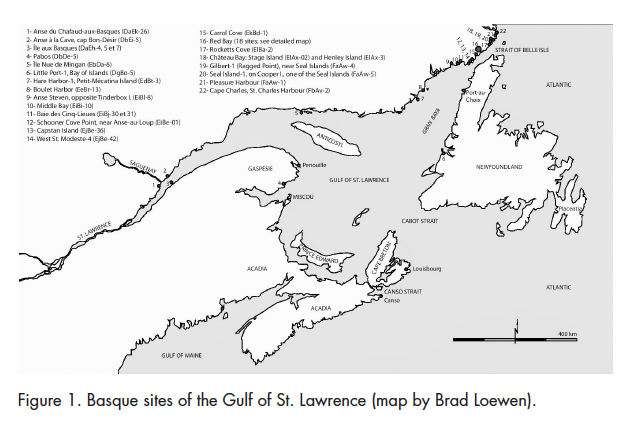 Display large image of Figure 1
Display large image of Figure 1
Amerindian Presence on Labrador Sites
5 Traces of an Amerindian presence at the Red Bay whaling station are concentrated on the northern shore of Saddle Island (Logan and Tuck, 1990: 7). Inside a small Basque habitation (EkBc-1, area C) were copper off-cuts from cauldrons for trying whale oil, as well as an Iroquoian-style ceramic shard. These artifacts lay with a deposit of roof tiles in the Basque occupation level (Tuck, 1986: 233). Garnet beads from 1550–1650 came to light in the same area. Claude Chapdelaine and Greg Kennedy assigned the pottery shard to the Iroquoian style of the Late Woodland period (Chapdelaine and Kennedy, 1990: 41–43). It is a rim fragment from a castellated pot with an incised decor. The upper register of the decor has two horizontal lines and punctuations. The main register is visible only in a few dentate impressions below the punctuation, but the shard assuredly comes from a pot with a complex decor.
6 At the western end of Saddle Island (EkBc-16), in an area of about 100 square metres near a whale-oil trying oven, James Tuck and his team found about 170 Amerindian hearths outlined by beach cobbles, some cracked by fire. Archaeologists were able to situate some hearths in the same stratigraphic level as the Basque occupation (Table 1). Most of the material in and around the hearths is lithic, consisting of flakes and scrapers in local stone, as well as bifaces, points, knives, and various tools in grey-green chert, quartz, quartzite, and Ramah quartzite (Robbins, 1989: 10; Tuck, 2005: 31–32). In addition, the hearths contained European wood, forged nails, calcined harp seal bones, leather, baleen, roof tile fragments, as well as 334 shards from at least two pots (Tuck, 1986: 216–18; 1989: 2–6). The pottery remains are highly fragmented and only one rim shard (EkBc-16-199) shows diagnostic Iroquoian-style incisions (Figure 2).
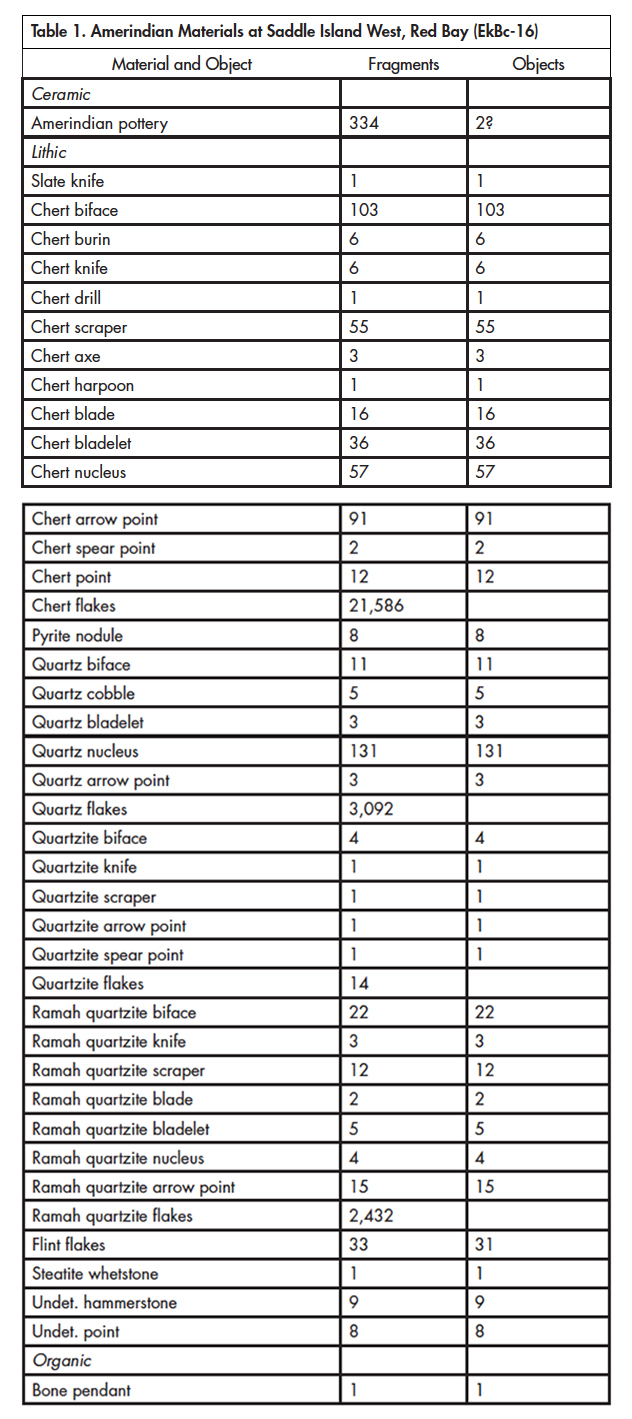 Display large image of Table 1
Display large image of Table 1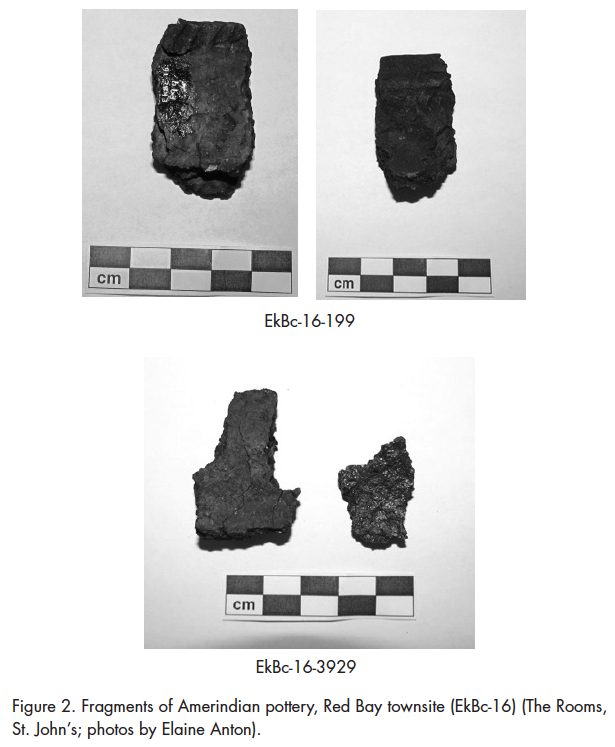 Display large image of Figure 2
Display large image of Figure 2
7 Despite the hearths’ stratigraphic position within the Basque cultural level, Tuck cast doubt on the simultaneous presence of Amer-indians and whalers. The lithic material can only be assigned to the Late Woodland, a period covering several hundred years, mostly before the Basques’ arrival (Tuck, 2005: 21–32). In addition, most of the calcined harp seal bones (Stephen Cumbaa, personal communication for Tuck, 2005) in the hearths are from pups born in late February to early March. The archaeologists suggest that these remains signify that any camps from the Basque whaling period were occupied at the end of winter, before the Basques’ arrival in spring (Tuck, 1987: 6–8; 1989: 217–18; Logan and Tuck, 1990: 70–71). A round, dark blue bead (type IIa55) was found in this context. This type may date to the sixteenth century but possibly also to the 1630–70 period, and is slim evidence for trade between Basques and Indigenous peoples. Selma Barkham has found historical evidence that Basques wintered at Red Bay in 1574, 1577, and 1604 — involuntarily because of ice in the first two instances, voluntarily in the last — but the documents do not mention any Amerindian coexistence or presence (Barkham, 1978: 17; 1980).
8 On the mainland opposite Saddle Island, in Red Bay town where the remains of a large whaling station were found (EkBc-17), our study of the collection shows Amerindian material not mentioned in archaeological reports (Delmas, 2018). Except for a non-diagnostic pottery shard, most of the assemblage is lithic (Table 2) and resembles that from Saddle Island. Importantly, the collection also contains glass beads that likely date from the sixteenth and seventeenth centuries, as well as wound beads from the first half of the eighteenth century that may be associated with Pierre Constantin’s post at Red Bay (Delmas, 2016: 82; Rankin and Crompton, 2016: 21–22). They illustrate the long occupation sequence of the Red Bay town site and the difficulty of distinguishing cultural phases within the thin, compressed archaeological deposits.
9 About 50 kilometres west of Red Bay, several Amerindian sites within the municipality of Blanc-Sablon, Quebec, at the present-day border between Quebec and Labrador, also contain Basque and other European artifacts. The site cluster known as Rive-Ouest-de-la-Blanc-Sablon shows 9,000 years of human occupation by various Indigenous and European groups (Pintal, 1998). It lies on the west side of the Blanc-Sablon River, a kilometre from the Gulf of St. Lawrence. Of the 68 sites in this cluster, three include contact period elements. Sites EiBg-1B and EiBg-123 contain European and Amerindian (mostly lithic) materials within the same level. Site EiGb-1B has copper and lead sheet metal, a dozen forged iron nails, a faceted black jet bead, and a fragment of Breton pottery. The only other instance of a jet bead found in the St. Lawrence basin is from the site of Cartier-Roberval, a 1535–36 French occupation near Quebec City. As for EiBg-123, it has numerous forged nails, roof tile fragments, a knife partly made with a copper alloy handle, scrapers chipped in European ballast flint, and baleen (Pintal, 1998: 50, 59).
10 A third site in the Blanc-Sablon cluster, EiBg-9, is centred on a hearth measuring 1 metre in diameter. Interpreted as an Innu site, it yielded a large number of calcined bone fragments, including caribou, cod, shore birds, and harp seal. The rest of the collection is European and consists of 60 forged nails, two elaborate keys, a length of copper wire, a flint nucleus, ten greyish white flint chips, baleen, cloth fragments, and 250 shards of coarse earthenware from four cooking pots (Red Bay types RB3 and RB4) that are characteristic of Basque whaling sites (Pintal, 1998: 238–41; Gusset, 2007: 59–72; Moussette and Waselkov, 2013: 163). Whether these items were obtained by trade or scavenging, they show a certain temporal equivalence of Basque and Indigenous presence (Figure 3).
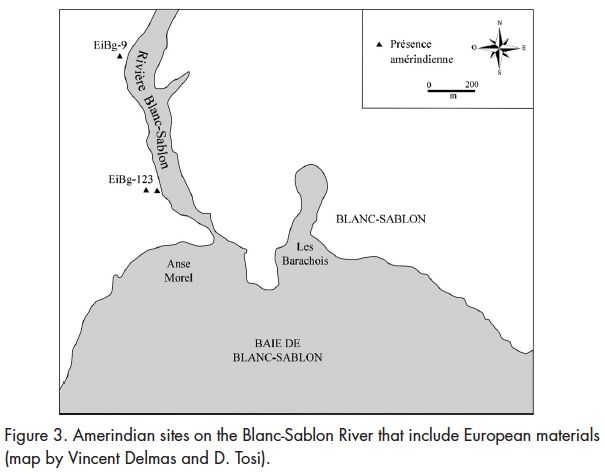 Display large image of Figure 3
Display large image of Figure 3
Amerindian Presence on North Shore and Estuary Sites
11 In the Mingan Archipelago, near one of the whale-oil ovens on Île Nue (EbDa-6), a few artifacts indicate a historical Indigenous presence (Table 3). A projectile point, off-cuts of laminated copper, a red glass seed bead, and a black chert scraper were found in the Basque occupation level near oven 52G4 (Drouin, 1988: 8). However, the site archaeologist, Pierre Drouin, has cautioned that a closer evaluation of the site is needed to assess whether First Nation people and Basques were present at the same time or whether trading took place. Although no Iroquoian-style pottery was found on Île Nue, Iroquoian materials have been reported on sites on the nearby mainland at Longue-Pointede-Mingan (Martijn, 1990: 55).
12 In the St. Lawrence Estuary, two other Basque sites contain Amerindian traces. The first is Anse-à-la-Baleine on the south side of Île aux Basques (DaEh-4). In the three excavation areas near a whaling oven, two Amerindian occupations were investigated (Table 4). Area 1, located 9 metres north of the oven, is focused on a hearth around which lithic and European materials were found in the same level. The lithic assemblage is composed of chert and quartz flakes, and a range of tools such as hammerstones, projectile points, bifaces, and scrapers of Témiscouata chert. One Amerindian ceramic shard and a small amount of Iberian pottery were found. Other European materials are nails and a harpoon in forged iron, lead shot, two brass rings, an opaque black glass bead (IIa7, dating to 1565–1610 according to Turgeon, 1994), a few fragments of table glass, a whetstone, flint flakes, and a European smoking pipe from the early seventeenth century. Réginald Auger and collaborators dated this mixed deposit of European and Amerindian artifacts to the middle of the seventeenth century and considered it to be later than the Basque occupation, which occurred between 1580 and 1635 in the Tadoussac region according to historical research (Auger et al., 1992: 51–65; Lalande, 1991: 8).
13 Area 2, adjacent to the oven (in Operation 1), has lithic and European materials that are similar in diversity and proportion to those of Area 1. It is distinguished by a large amount of Amerindian pottery from the Late Woodland period (DaEh-4-1X3-1) and a Basque-style cooking pot, all found in the oven’s occupation level. One Indigenous vessel could be partially reconstructed. Recovered and described over three seasons, its style and stratigraphic position were interpreted in different ways, and its date was assigned variously to the Early, Middle, and Late Woodland periods. Its position in the Basque occupation level, either in the lower or upper portion, was uncertain (Auger et al., 1992: 65–70; 1993: 59–61; Lalande, 1991: 22). As for its cultural affiliation, Chapdelaine and collaborators ask whether the vessel represents an Iroquoian or an Algonquian style (Chapdelaine et al., 1992: 96–101). Despite these questions, the site archaeologists concluded that there was an Amerindian occupation before the construction and use of the whaling oven, and another after the period of Basque activity.
14 Area 3, located 12 metres west of the Anse-à-la-Baleine oven, is focused on a small Basque workshop with an indistinct outline, also showing a hearth and a stone alignment. No Amerindian ceramics and a single chert flake were found. Associated European artifacts were shards of an Iberian cooking pot and two glass beads. One bead is an opaque white tubular example (type IIa15), conventionally dated between 1600 and 1630. The second is a translucent turquoise round bead (type IIa30/40), typical of two separate “Glass Bead Periods,” circa 1580–1600 and circa 1630–1650/1670 (Auger et al., 1993: 134–40). While glass beads are often associated with European–Indigenous trade, considering their small number on this site, they may have fallen from a piece of apparel during an isolated visit to Île aux Basques by Europeans or First Nations.
15 While not evidence of direct contact, the data from the three excavation areas on Île aux Basques point to broadly coeval occupations by Basques and Indigenous people. At the western end of the island, Charles Martijn excavated a site (Cache site, DaEh-1) showing repeated occupations by small Iroquoian groups in prehistoric and historic times (Martijn, 1969; Raymond-Rioux, 1997: 21, 143). As at Île Nue de Mingan, investigation around other ovens may yet determine whether there was direct contact between Iroquoians and Basques.
16 The second Basque site showing an Amerindian presence in the St. Lawrence Estuary is Anse-à-la-Cave (DbEi-5), east of Tadoussac. Dominique Lalande and Michel Plourde have shown that the rocky point where two Basque ovens are located also contains vestiges of prehistoric and historic Amerindian occupations (Table 5) (Lalande, 1987, 1989, 1990, 1993, 1994, 2008; Plourde, 2003, 2012). Combustion features, stone tools, and ceramics show the use of this location for winter hunting by Amerindians from the thirteenth through the sixteenth centuries. Do these extensive data indicate European–Indigenous contact in the historic period? On this site, archaeologists laid out no less than nine excavation operations. Operation 1 includes a Basque-style oven with two hearths but no Indigenous artifacts. However, the adjacent Operations 4 to 7 revealed Amerindian material. Operation 4, located southwest of the oven, corresponds to the cooperage workshop. Within the building’s outline, archaeologists found bones and lithic material associated with Iberian cooking pot fragments, table glass, lead shot, and lead overflow from a shot mould, as well as a white opaque barrel-shaped bead of a type (IIa14) assigned to the years 1600–30 (Lalande, 1994: 23–30).
17 Operation 5, located southeast of the oven, revealed a hearth containing calcined bone, marine shell fragments, lithic flakes in local stone, European flint chips, Indigenous pottery, and an Iroquoian smoking pipe, in addition to a Cornaline d’Alep bead (IVa6) with a green core and a dark red outer laminate. Operations 6 and 7 found other hearths, associated lithic material, and equal proportions of fresh and calcined bones. Most of the bones came from seal, moose, beaver, fox, and duck species. Finally, Operation 2, located some distance away, targeted an eighteenth-century Basque oven linked to the Darragorry brothers of Saint-Jean-de-Luz. Archaeologists found no lithic material or Amerindian ceramics. Operations 3, 8, and 9, located south and east of the Darrogorry oven, revealed lithic material similar to that found near the first Basque oven, as well as eighteenth-century European material (Lalande, 1990: 37; 1994: 23–34).
18 Michel Plourde has analyzed the Amerindian lithic and ceramic materials from this site (Plourde, 2012). The débitage is dominated by chert-argilite, Mistassini and Ramah quartzite, and white to translucent quartz. The stone tools include scrapers, pieces esquillées, points, knives, bifaces, a hand pestle, and an axe pre-form. Many tools are fabricated in a green radiolarian chert or in Ramah quartzite. Of the 30 ceramic shards in Operation 5, Plourde distinguished at least three vases with a corded or a check-stamped decor, which he related to St. Lawrence Iroquoians. Lalande and Plourde noted that the site’s thin soils contain a mixture of “prehistoric” and “historic” materials, including instances of prehistoric objects on the surface, leading to difficulty in interpreting and dating the occupations (Ruralys [Lalande], 2008; Plourde, 2003: 170; 2012: 75, 101, 132–33, 202, 232).
19 Plourde has suggested that the Iroquoian presence at Anse-à-la-Cave began at the outset of the Late Woodland period, soon after AD 1200, and continued to the late sixteenth century. While glass trade beads are present, they are few in number (n = 2) and do not in themselves show that Amerindian and Basque occupations were strictly contemporaneous. Flint flakes, listed as an Indigenous material on most of the sites under review, may represent an Indigenous reuse of materials left by Basques or a later trade material. Gunflints are a seventeenth- and eighteenth-century artifact that, along with trade beads, have been used to date Indigenous presence after the Basque occupations that are assigned to the 1580–1635 period. At Anse-à-la-Cave, Amerindian presence has been interpreted in a similar way to that on Île aux Basques, that is, before and after the period of Basque activity, despite the proximity of the Tadoussac trading post where direct contact may have occurred.
20 In a further effort to bridge the gap between European and Indigenous presence, Michel Plourde reassessed 10 sixteenth-century Iroquoian sites near the mouth of the Saguenay River for indications of European contact (Plourde, 2016). All of these sites had St. Lawrence Iroquoian pottery, and seven also had glass trade beads similar to examples from Île aux Basques and Anse-à-la-Cave. These small bead assemblages have close parallels with larger collections from Tadoussac and Chicoutimi (Moreau, 1994; Moreau et al., 2016), and from a late Iroquoian site at Cap-Tourmente near Quebec City (Chapdelaine, 2016). In total, the beads include types that belong to the sixteenth century, while the majority can be assigned to the period from 1600 to 1630 as defined on Ontario Iroquoian sites. Since St. Lawrence Iroquoians are considered to have disappeared before 1600, Plourde questioned whether these bead types were distributed by Malouin (Breton) and/or Luzien (Basque) traders who were at Tadoussac from 1579 to 1599, or whether Algonquian people who moved into the region about 1600 visited the former Iroquoian sites and lost the beads, without leaving any other sign of their passage (Plourde, 2016). Another hypothesis is that some dispersed St. Lawrence Iroquoians re-settled in the lower St. Lawrence Estuary, where their identity, ceramic style, and Basque relationship continued into the 1630s, after which they were assimilated into the Algonquian culture (Loewen, 2016; cf. Moussette, 2016: 131). These uprooted Iroquoians may have left both the pottery and the glass beads between 1600 and 1635 on the 10 Iroquoian sites studied by Plourde and at the Basque sites of Anse-à-la-Cave and Île aux Basques. If so, these sites may show the last decades of the “privileged partnership” that Charles Martijn hypothesized between Basques and St. Lawrence Iroquoians (Martijn, 1990).
Inuit Presence on Basque Sites
21 While Amerindian presence is shown on Basque sites from Labrador to the St. Lawrence Estuary, Inuit traces are limited to the Strait of Belle Isle and the lower North Shore. In the sixteenth century, the Inuit expanded southward along the Labrador coast to the Strait region and from thence to northern Newfoundland and the Quebec lower North Shore, following marine mammals and seeking European materials. Some Inuit camped on unoccupied European fishing stations to gather abandoned materials, while others worked and traded on the stations in direct contact with the French fishing crews (Trudel, 1981: 290–94, 329).
22 Archaeology has shed considerable light on the Inuit expansion into southern Labrador in the sixteenth to eighteenth centuries. It appears that Inuit southward migration was partly motivated by the European arrival and the chance to obtain goods for use and trade (Stopp, 2002: 82–83). Basque ceramic roof tiles and forged iron nails are found in Inuit houses far to the north on the Labrador coast. In the southern Inuit range, summer tent rings and large winter houses show year-round occupation of the Strait and the lower North Shore from at least the middle of the seventeenth century. Inuit incorporated European items, especially metal materials, into their hunting and fishing practices (Stopp, 2002: 71; Brewster, 2006; Rankin, 2009: 25–26, 35; Murphy, 2012: 16–17).
23 On Basque sites, traces of Inuit presence have been identified at Red Bay and Petit-Mécatina. For the sake of completeness, we will also mention data from Chateau Bay, although their relation with the Basque occupation is more distant. As in the case of the Amer-indian vestiges, we will assess their temporal relation to the Basque occupations.
Inuit Presence on Basque Sites in Labrador
24 Near the Red Bay town site (EkBc-12), test pits have brought to light small amounts of Inuit material life (Tuck, 1984: 226–28). More contextualized remains were identified in the northeast sector of Saddle Island (EkBc-1, Area J), where a small habitation with Basque material in its occupation level was excavated. Among the soils of the collapsed sod roof were a stone drill bit, a steatite bowl, seal vertebrae, and a fragment of a ground slate endblade. These objects were not below the roof remains, and James Tuck judged them to be later than the structure’s Basque occupation. The same soils included materials assigned to the Dorset culture, showing they had been occupied prior to their use in the roof. 1
25 About 600 metres east of Saddle Island, the Twin Isles hold two sites potentially associated with Inuit. James Tuck was keenly interested in a possible overlap of Basque and Inuit occupations on Twin Isles, and so we will mention materials from both these cultural groups. The first site (EkBc-5) has a rectangular structure measuring about 6 by 8 metres outlined by stones and whale vertebrae, next to a sheltering rockface (Tuck, 1981: 77; 1984: 78–80). A roof structure is indicated by post holes that frame a hearth. Related artifacts are mostly European and include 98 forged iron nails, including some that are reworked; 40 lithic items, including flint flakes (Table 6); 35 European smoking pipe fragments that date to the seventeenth century or later; 28 lead shot of various calibres; and two green-coloured shards of glass. Of diagnostic value are two round blue beads (IIa37, IIa41) and four round white beads (IIa11) that likely date to the seventeenth century (Delmas, 2016: 81). The site’s small extent and limited material culture hamper its clear interpretation as an Inuit occupation.
 Display large image of Table 6
Display large image of Table 626 The second site on Twin Isles, EkBc-7, is focused on a summer tent ring, a midden, and both Inuit and Basque material found in a neighbouring pond (Table 7). Measuring 4.75 metres in diameter, the tent ring is outlined by whale vertebrae. The associated material culture was found in the upper levels inside the tent and in the adjacent midden. Except for faunal remains and a steatite lamp fragment, the objects are essentially European forged nails and flint flakes. The site’s lower level contained numerous wood chips, forged nails, tile fragments, and baleen fragments that are similar to the extensive Basque remains on Saddle Island (Pastore and Auger, 1984: 57–58). These results led James Tuck to conclude that an Inuit occupation took place on Twin Isles after the period of Basque whaling activity at Red Bay.
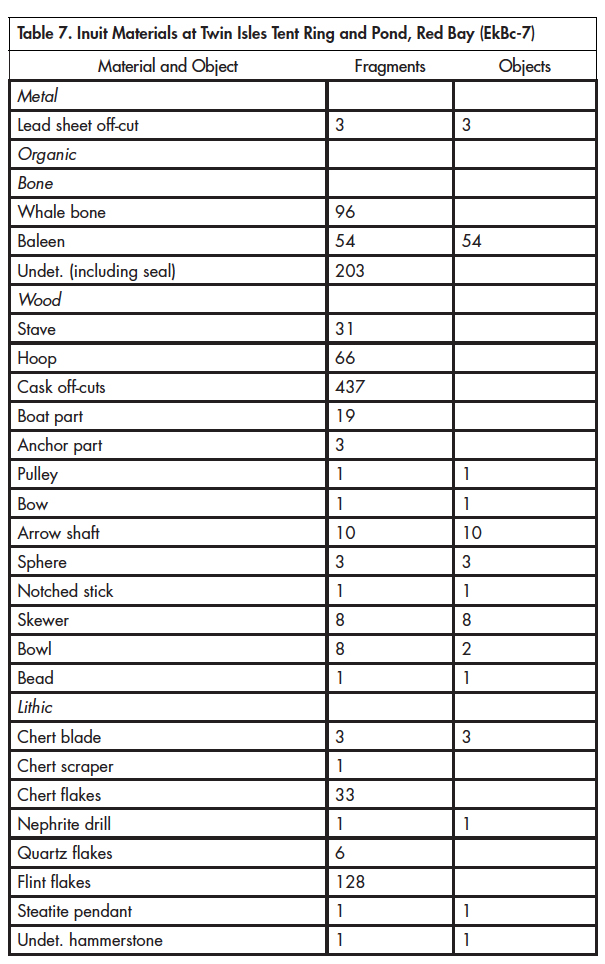 Display large image of Table 7
Display large image of Table 727 The archaeologists also drained and excavated a pond located near the tent ring. Its assemblage is more diverse and included extensive organic remains (Table 7). Bones included a dozen whale vertebrae and skeletal remains of various birds and mammals, including seal. Some of the many wood fragments had identifiable shapes. A series of logs of local species, about 15 to 20 centimetres in diameter and 3 metres long, may have come from an adjacent structure built in the style of the workshops found on Basque whaling stations, notably at Chateau Bay. Among the European wooden objects were a ship’s rigging pulley made of oak (EkBc-7-688), pieces of a beech bowl that was identical to examples found on the wreck of the San Juan, a whaling ship lost at Red Bay in 1565 and excavated by Parks Canada archaeologists from 1978 to 1985, and a tool consisting of a metal hook and a wooden handle possibly used to handle whale blubber. A wooden disk with a handle (EkBc-7-56) was interpreted by Tuck as a thrown decoy, called a paleta in the Basque Country, used to frighten flocking birds and drive them into a net. This disk could also be interpreted as a lid for a ceramic pot. Other objects were a bi-conic wooden bead (EkBc-7-1004), a wooden stick with notches that may had an accounting function (EkBc-7-1297), fire-blackened cooking skewers made from oak cask staves (Figure 4), and arrow shafts made of pine wood (EkBc-7-622, 630, 636, 918, 1078, 1244) (Tuck, 2005).
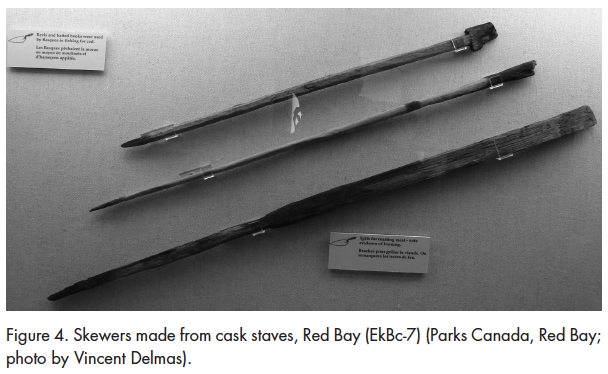 Display large image of Figure 4
Display large image of Figure 4
28 Material from the pond included numerous forged nails, modified iron objects, lead shot of various calibres, and a nearly complete glass goblet. Also found were a slate blade (as on Saddle Island), a nephrite drill, a hammerstone, reworked chert fragments, and a steatite pendant associated with a string of seal vertebrae. Although there were roof tile fragments, no Basque-related pottery shards were found. There is no doubt that this collection reveals Inuit presence on Twin Isles. James Tuck queried the Basque use of the oak skewers and modified metal fragments. He proposed that the Basque materials were gathered and recycled by the Inuit, whose presence on Twin Isles — according to the stratigraphy of the sod-roofed habitation and the tent ring area — took place shortly after the sixteenth-century Basque occupation (Tuck, 1983: 78–82; 1984: 229–39; 2005: 36; Stopp, 2002: 86).
29 In the first half of the eighteenth century, the Quebec City merchant Pierre Constantin operated a sealing station at Red Bay. James Tuck investigated the area of his habitation, northwest of Red Bay harbour, while Amanda Crompton has looked at historical data on Inuit stances towards Constantin and European fishers in general in the region. Inuit burned down the sealing station in 1719 and three employees lost their lives. Groups of Inuit moved along the Strait of Belle Isle in September to gather European materials from fishing stations (Crompton, 2015: 129; Mitchell, 2013: 322).
30 Finally, east of Red Bay, at Chateau Bay, two Basque whaling stations on Stage Island (ElAx-2) and Henley Island (ElAx-3) were investigated by Basque archaeologists in 1985 and 1989. While testing on Henley Island showed no Indigenous materials, traces of Inuit presence were detected on adjacent Whale Island where three food caches holding seal bones were found. Although no datable materials were found here, the archaeologists posited a date after the Basque occupation, in the eighteenth or nineteenth century (Vera et al., 1986; Azkarate et al., 1992).
31 On nearby Stage Island, excavation of a wooden structure near a major Basque whaling station revealed a few osteological artifacts (ElAx-2-868, 870) and lithic material assigned to an Inuit presence (Table 8). This material was discovered in levels later than the Basque occupation, as on Whale Island (Azkarate et al., 1992: 86, 120, 234– 40). Greg Mitchell has sought to correlate these findings to the 1765 treaty between the Inuit and the Governor of Newfoundland, Hugh Palliser, concluded at Chateau Bay to end decades of hostilities. By this treaty, the English aimed to protect their fisheries, colonies, and trade in Newfoundland and Labrador, and to contain the Inuit — without success — in northern Labrador (Mitchell, 2013: 323).
Inuit Presence on Basque Sites on the Lower North Shore
32 A single Basque site on the lower North Shore, Hare Harbour 1 on Petit-Mécatina Island (EdBt-3), has provided evidence of an Inuit occupation (Figure 5). William Fitzhugh and Eric Phaneuf have extensively excavated land and underwater components on this site. They identified two European cultural phases. The first phase is seen through Basque material from Spain (found both underwater and on land) that broadly mirrors the reference sites of Red Bay and Cap-Bon-Désir, and thus appears to span the late sixteenth and early seventeenth centuries. The second phase (found only on land) is seen through material culture that, in addition to Basque-related ceramics, includes Norman stoneware, French trade beads, and clay smoking pipes. The second European cultural phase occurred sometime between 1650 and 1730, and may be Basque, French, or French-Canadian in origin. As for the Inuit cultural remains, they are found only on the site’s land component, principally associated with an Inuit house (Structure 3) in the site’s eastern portion and with two Inuit houses (Structures 4 and 5) in its western portion. A full analysis of their relation with the two European occupations is still in progress (Table 9).
 Display large image of Table 9
Display large image of Table 933 No historical records mention this site prior to 1730 and thus its occupation sequence relies entirely on stratigraphic analysis. The underwater component is dominated by several elongated piles of ballast stones, between which are stratified deposits up to 60 centimetres thick and showing three general levels. From the bottom up, these levels are characterized by (1) brushwood and timber debris, (2) abundant cod bones in the middle level, and (3) tiles from a collapsed roof in the upper level, especially in areas farther from the shoreline. The wood debris and fishbone levels encase many artifacts typical of Basque sites in Labrador and the St. Lawrence Estuary (Escribano-Ruiz and Barreiro Argüelles, 2016). Thus the underwater site tells the story of the construction, occupation, and abandonment of a sixteenth- to seventeenth-century Basque fishing station, whose operations extended some distance over water. A few Indigenous-associated objects in the site’s underwater area include two glass beads, 2 a scraper made of green bottle glass, and stone chipping flakes. These items are exceptional on the submerged site where the great majority of material culture is Basque, and notably excludes the Normandy stoneware and Inuit artifacts found on the land portion of Hare Harbour 1.
34 The land site is more complex, however, a series of structures seem to outline three cultural phases. The oldest is represented by the charred remains of a rustic floor made of recycled barrel staves, roof tile fragments, and flagstones that were laid on the humid natural soil, showing an Inuit winter habitat (Structure 3). The second phase is indicated by the flagstone floors of two buildings that Fitzhugh named a “cookhouse” (Structure 1) and a “smithy workshop” (Structure 2). The “smithy workshop” directly overlies the older Inuit house. Immediately west of the “cookhouse” lay a mass of Basque roofing tiles, perhaps resulting from the replacement of the building’s first roof. Finally, a third cultural phase is indicated by two contiguous Inuit houses (Structures 4 and 5) that are set away from the older structures. Their later strati-graphic position was inferred from the presence of Inuit artifacts in soils that cover the “cookhouse” and “smithy workshop” floors, as well as the mass of roofing tiles (Fitzhugh, 2010a: 37–48). Hare Harbour thus shows distinct phases of European material culture, and two separate phases of Inuit presence.
35 The older, rustic floor made of Basque tiles and staves (Structure 3) was interpreted as an Inuit house on the basis of its entry tunnel and associated artifacts that include a bow and a miniature steatite lamp, in addition to forged nails and a small wooden box similar to an example from the wreck of the San Juan (Gusset, 2007: 209–18). This house shows the recycling of Basque-related building materials such as wood and nails, but few domestic utensils or hunting tools that originated in Europe.
36 The two later Inuit houses (Structures 4 and 5) lie about 20 metres from the “cookhouse” and “smithy workshop,” adjacent to a high overhanging cliff. This portion of the site contains an extensive horizon of charcoal, produced in a pit located at the site’s western limit, possibly as fuel for the “smithy workshop.” In one spot, six strata of charcoal debris, alternating with trampled soil, suggest multiple episodes of charcoal production (Fitzhugh et al., 2006: 26–27). Charcoal was used abundantly to level the flagstone floors of the Inuit houses and build up their wall foundations, whose remains are a mixture of rocks, sod, and large quantities of charcoal. Artifacts associated with the charcoal horizon and the Inuit houses are quite similar, including Inuit objects, Normandy stoneware, Basque earthenware, Dutch pipes, and French or Dutch glass beads. Similar artifacts were also found with the “cookhouse” and “smithy workshop,” leading Fitzhugh to speculate on a possible “joint venture” of Inuit and Basques (Fitzhugh, 2011: 69).
37 The dimensions of the two later Inuit houses are 4 by 8 metres for Structure 4 and 6 by 6 metres for Structure 5. Each has a single room whose central area is paved with flat rocks and roof tiles, with an earth sleeping platform along the back wall. At the front, facing south towards the water, are the entry corridors whose floors are lower than the house floors, thus creating a “cold trap.” The entryway of Structure 4 is 2 metres long and 1 metre wide, while that of Structure 5 is 4 metres long and 1 metre wide. Structure 5 lacks one wall and has few associated artifacts, suggesting that it may not have been finished and used. Structure 4, on the other hand, has numerous signs of occupation. Its interior space and the nearby midden (in Area 8) contain mostly European artifacts and, to a lesser extent, Inuit material. The occupation level contains many charcoal nodules, clearly from the European-style charcoal pit. Few food remains have survived, perhaps due to soil acidity.
38 In many ways, the two structures and their material culture are typical of Inuit winter houses in southern Labrador. Moreover, the material culture is no different from that found elsewhere at Hare Harbour 1. It is dominated by forged nails of various sizes, followed by knife blades and other iron tools, fragments of Iberian and French coarse earthenware, Normandy stoneware, Aragon majolica, European smoking pipes, lead fish-hook sinkers and sounds, shot of various calibres, broken steatite lamps and containers, glass beads, and glass tableware. Notable finds in Structure 4 include an axe, a welded cluster of heated iron nails, lead sheet fragments, fishing hooks made of bent iron nails wrapped in strips of lead sheet (EdBt-3-6390, 6391), and pyrite lumps for lighting fires (Fitzhugh, 2011: 63–67; Fitzhugh and Phaneuf, 2012: 48–56).
39 Six glass beads found in the “cookhouse” (Structure 1) were analyzed by neutron activation to determine their geochemical composition and position them on a chrono-chemical reference curve (Herzog and Moreau, 2006). The beads were all round monochrome varieties: one black, one red, one white, one navy blue, and two turquoise. This analysis suggested a date of 1680–1730 for the four white, navy blue, and turquoise beads, and thus for the “cookhouse” occupation. The same bead varieties were found in analogous proportions in the “smithy workshop” and the two later Inuit houses. Testing of the Inuit midden (Area 8) yielded fragments of Dutch smoking pipes, including one with an “EB” mark attributed to Edward Bird, his son, or his widow in Amsterdam, c. 1630–72 (Duco, 2003). The soils and artifacts associated with the Inuit house show no stratigraphic or spatial distinctions, suggesting a single occupation by one or more Inuit families.
40 Hare Harbour 1 was thus occupied between the mid-seventeenth and early eighteenth centuries by Inuit, Basques from Spain, and a third European group that is visible by its Iberian earthenware, Normandy stoneware, French beads, and Dutch pipes. The Inuit occupied the site twice, before and after the existence of the “smithy workshop” (Structure 2). Considering the purely Basque affiliation of the underwater component, it seems that Basques occupied the site first. Based on the mixed Basque–Inuit assemblage associated with the rustic, burned floor (Structure 3), Inuit occupied the site in subsequent seasons or years, and we cannot exclude the possibility of overlapping or alternating Basque and Inuit occupations. As for the second European and second Inuit occupations, they too may have overlapped for a time, although the Inuit presence appears to extend later and closes the site’s cultural sequence.
41 The history of Petit-Mécatina is poorly known during the period suggested by the site’s material culture. Michael Barkham has documented Basque fishing in western Newfoundland from the late sixteenth century to 1713 (Barkham, 1989), and this fishery likely extended to the Gulf ’s lower North Shore. The same time period coincided with the Inuit southward expansion into the Gulf of St. Lawrence. Augustin Le Gardeur de Courtemanche (1663–1717), who traded and sealed along the coast from Kegashka to Hamilton Inlet after 1703, maintained cordial relations with the Innu under his command at Brador, but had more ambiguous and even hostile relations with the Inuit. He complained of theft and destruction of fishing equipment, and seems to have feuded with the Inuit for economic and territorial reasons. As late as 1705, he wrote of Basque sealers from Spain near Brador (Belvin, 2006: 29–30, 35–36). Petit-Mécatina enters the archival record in 1740, when it was included in a sealing and trading concession (Belvin, 2006: 41).
42 In a review of Inuit presence on the North Shore, Marianne Stopp mentions two references to Inuit at “Mécatina” (Stopp, 2002). The first is by Louis Jolliet (1645–1700), seigneur of the coast from the Mingan Islands to Brador, in the journal of his 1694 expedition to Labrador. He stated that Inuit had wintered at Gros-Mécatina Island in three houses made of sod and wood. The second reference is by François Martel de Brouague (1692–1761), Courtemanche’s stepson and successor as Brador commander. Brouague related in 1728 that Canadian and Innu winterers had killed two Inuit families at “Mécatina” — presumably on the coast near Baie-des-Moutons. The only survivors were an Inuk girl and her mother (Stopp, 2002: 77). Although Petit-Mécatina is not named, these references show Inuit in the general region during the period indicated by the Dutch pipes and the French beads at Hare Harbour 1.
Discussion
43 Early archaeological views on relations between Basques and Indigenous peoples show the influence of a paper in which Selma Huxley Barkham cast doubt on the existence of any meaningful contact in the sixteenth century (Barkham, 1980). In several major site reports, archaeologists found the reasons against contemporaneous Basque and Indigenous presence to be more convincing than those allowing for this possibility. The main sticking points were the lack of strati-graphic clarity, the argument that strategic sites (especially in the Strait of Belle Isle) were often independently reoccupied by different cultural groups, and difficulties of reconciling the material culture with the presumed cultural chronologies of Basques, Inuit, and St. Lawrence Iroquoians in the study region. Glass trade beads in particular played a role in archaeologists’ reasoning. These objects, considered to be datable within fairly tight limits and to indicate Indigenous trade with Europeans, were usually more recent than the presumed period of Basque occupation. In these early analyses, the following chrono-cultural limits were assumed:
- Basques: Labrador, 1530–c.1600, rarely to 1635; St. Lawrence Estuary, 1580–1635
- Glass Bead Periods 1 to 4: 1580–1600; 1600–30; 1630–70; 1670–1760
- St. Lawrence Iroquoians: c.1450–1580
- North Shore Inuit: c.1600–c.1800
44 From these site reports and related articles, the perception emerged that Indigenous people visited abandoned whaling stations after 1600 or 1635 to collect useful materials and lost their beads in this context. This perception was itself related to the idea that Inuit avoided contact with Europeans (see Pope, 2015). It remained a theme of archaeological thought, despite several articles arguing in favour of Basque–Indigenous contact (Bakker, 1989, 1996; Turgeon, 1990, 1991, 1994, 1998; Chapdelaine and Kennedy, 1990; Martijn, 1990; Martijn et al., 2003). A tipping point came when Marianne Stopp showed evidence of early Inuit trade with Europeans (Stopp, 2002) and William Fitzhugh showed Inuit winter houses, with associated European material, on the Basque site of Petit-Mécatina (Fitzhugh, 2010a). Since then, other scholars have re-examined data to suggest sustained Basque–Indigenous relations in the Strait of Belle Isle, at the mouth of the Saguenay River, and in Chaleur Bay (Delmas, 2016, 2017; Chapdelaine, 2016; Castro, this volume; Loewen, 2016a, 2016b, 2017; Loewen and Egaña Goya, 2014; Birch and Williamson, 2013: 146–49).
45 In addition, recent research shows that Basque presence on the North Shore extended later than previously thought. It now appears that Basques from Spain only retreated from a given stretch of coastline when it was granted to a French colonial seigneur. Thus, four key grants resulted in a west-to-east wave of cultural handovers, from transatlantic Basques to resident Canadian French (Loewen and Delmas, 2012; Escribano-Ruiz, 2014; Loewen, 2017):
- 1635 in the Tadoussac region
- 1661 in Sept-Îles (Île-aux-Oeufs concession)
- 1679 in Mingan (Îles-de-Mingan concession)
- 1703 in Labrador (Brador concession)
Notably affected by this chronological revision was the interpretation of seventeenth-century glass beads, which now coincided with the time of Basque presence, or with incipient Canadian French trade in the wake of the Basques’ eastward retreat.
46 As scholarly thought evolved, a broader need arose to reconsider the archaeological evidence of Indigenous presence on Basque sites. While data on several sites remain inconclusive, contact of some kind may have occurred at Petit-Mécatina, the Red Bay complex, and Île aux Basques.
Petit-Mécatina
47 Linking the Inuit and European occupations are the Normandy stoneware, the smoking pipes, the beads, and the charcoal deposit. Stoneware appears on the North Shore in the mid- to late seventeenth century. Despite presence of Normandy stoneware and probably French green-glazed coarse earthenware, the ceramic assemblage includes seventeenth-century Basque material and appears to be a seventeenth-century evolution of the Basque ceramic imprint on the North Shore (Delmas, 2017). One smoking pipe, marked “EB,” was produced between 1630 and about 1672 (Duco, 2003). The beads concur with this date from a stylistic standpoint (Delmas, 2016; Herzog, 2009). The assemblage includes two “Roman” beads. It is thought that Dutch traders introduced this type at Albany, New York, in the 1650s or 1660s, and that Mohawk intermediaries distributed it into the St. Lawrence Valley up to the 1670s (Kenyon and Kenyon, 1983). From a chrono-chemical standpoint, the white and blue monochrome beads have been assigned to a slightly later bracket, circa 1680–1730 (Herzog and Moreau, 2006). As for the charcoal, made in a pit on the site and used in the later Inuit houses’ foundations, a comparable deposit has been found on Saddle Island (EkBc-1, area M). It is possible that Inuit produced charcoal fuel for Basque fishermen during the off-season, as part of agreements that enabled Basques to reduce the supplies brought annually from Europe. Although Petit-Mécatina is not mentioned historically, the site is valuable as a date and context for Basque–Inuit contact in the seventeenth century.
Red Bay Complex
48 While most of the Red Bay sites contain components of a major sixteenth-century Basque whaling station, several sites also show seventeenth- and eighteenth-century occupations. Notably, historical records reveal two waves of Basque sedentary sealing in the Strait of Belle Isle, about 1600–35 and around 1690. Red Bay is mentioned during the first wave. Basque crews wintered here and clashes with Inuit are documented, possibly over access to the seal resource. In the second wave, sites at the western end of the Strait are named (Loewen, 2017; Castro, this volume). Another reoccupation of Red Bay occurred from 1713 to 1732, when the Canadian French trader Pierre Constantin operated a trading and sealing post at Red Bay. His residence was on Peter’s Brook, while his sealing operation was in the area of BkEc-17 and Twin Isles. Constantin had a French and Innu workforce, and his men clashed with Inuit on at least one occasion (Crompton, 2015).
Saddle Island
49 In area C of EkBc-1, several objects found in a small Basque-style habitation suggest sixteenth-century Amerindian contact. The most notable objects were copper off-cuts, an Iroquoian-style rim shard assigned to the period before 1580, and two garnet beads that are common on Spanish colonial sites about 1550–1650 but rare in the St. Lawrence basin. Another garnet bead has been found at Lake Abitibi, together with Wendat (Huron) pottery from 1550 to 1650 and trade beads from Glass Bead Period 1 (1600–30) (Moreau et al., 2016: 155). On Saddle Island, these artifacts were synchronous with the Basque occupation. Their discovery led Charles Martijn to propose a link with the record of Iroquoians from Stadacona who travelled to the Strait of Belle Isle in 1542, and led to his hypothesis of a “privileged partnership” between Basques and Iroquoians (Martijn, 1990).
50 On EkBc-16 at Saddle Island, a concentration of 170 hearths within an area of 100 square metres — an average of 1.7 hearths per square metre — is the focus of another possible contact. Lithic artifacts and a bead found in this area led James Tuck to consider an Indigenous presence. The round, dark blue bead (type IIa55) may date to the sixteenth century, but this type is most common in Glass Bead Period 3 (1630–70). The same type of bead occurs on several Basque and Inuit sites, sometimes as the only bead recovered. These data are stratigraphically synchronized with Basque presence on Saddle Island, either at the height of sixteenth-century whaling or during a later sealing enterprise. The campfires appear to have been kindled in a snow-free season, while the harp seal bones led Tuck to suggest an occupation at the end of winter. Data from this area thus indicate a seventeenth-century Indigenous presence related to seasonal sealing activities.
Twin Isles
51 Sites EkBc-5 and EkBc-7 show an Inuit presence associated with Basque materials. A winter occupation is presumed for the Inuit-style house (EkBc-5), while a summer occupation is suggested for the tent ring and pond midden (EkBc-7). These habitations provide rare evidence of two-season Inuit occupation in southern Labrador (Mitchell, 2013, 2015). However, they were not occupied during the same period, as the summer tent ring and midden contain an abundance of material typical of sixteenth-century Basque whaling technology but no datable European objects, while the winter house contains seventeenth-century European beads and smoking pipe fragments. Loewen (2017) has drawn attention to the site’s environment within the reefs and rocks at the eastern end of Red Bay harbour, ideal for netting and hunting seal.
Red Bay Town Site
52 Of all the Red Bay sites, EkBc-17, located in the present town, has the longest apparent history of use. James Tuck commented on the repair and reuse of the Basque ovens, but did not remark on the eighteenth-century date of the wound glass beads at this site, which establish a connection with Pierre Constantin’s sealing and trading operation. Similar “eye beads” have been found at Nain and Chicoutimi, shedding light on the distribution network of these early eighteenth-century temporal markers (Brad Loewen, personal communication, 2017). Evidence of Indigenous contact on EkBc-17 thus likely belongs to the French period of Red Bay.
Île aux Basques
53 On this site (DaEh-4) near the mouth of the Saguenay River, three areas yielded evidence that has been assessed from the perspective of possible Basque–Amerindian contact. In one area, a black glass bead (IIa7) was assigned to the period before 1610, while an “early” seventeenth-century European smoking pipe were found in an Amerindian context judged to be later than the Basque use of the nearby oven. In another area, pottery assigned to an Iroquoian or Algonquian cultural affiliation was found in two levels, before and after Basque presence. Finally, around an Amerindian hearth, diagnostic artifacts included shards of an Iberian cooking pot, and two glass beads (IIa15, IIa30/40) show some form of contact with Basques and/or French in the region, in the early seventeenth century. This evidence has been linked to historical data on Basque trading and whaling around Tadoussac from about 1580 to about 1635 (Turgeon, 1994).
54 While stratigraphic uncertainty at Île aux Basques prevented archaeologists from suggesting direct contact between Basques and Amerindians, broader archaeological research in the St. Lawrence Estuary has revealed a recurring pattern of Iroquoian pottery and beads from Glass Bead Periods 1 (1580–1600) and 2 (1600–30) (Plourde, 2016; Loewen, 2016b: 271). While the Basque role in this pattern is not well documented archaeologically, some researchers have hypothesized a cultural and economic partnership between Basques and St. Lawrence Iroquoians from about 1540 to about 1630 — with the Iroquoians participating as a semi-sedentary group to about 1580, then as a nomadic group to about 1630 (Martijn, 1993; Loewen, 2016a: 71–72).
Conclusion
55 A large body of archaeological evidence reveals an attraction for the same sites by Basque, Iroquoian, Innu, and Inuit groups, as well as by French inhabitants. Indigenous presence is reflected by seasonal camps near or in the centres of Basque activity, and by diagnostic materials occurring in some cases far from their core territory, notably the Iroquoian pottery at Red Bay. An Inuit affiliation clearly emerges from winter houses and material culture artifacts. On the other hand, identifying specific Amerindian groups is often less certain, since Late Woodland ceramic styles were used by many groups over a long period, not only during the time of Basque activity.
56 Indigenous presence is nonetheless a recurring aspect of several Basque sites, including multiple components at Red Bay and Petit-Mécatina. It appears as a mixture of Indigenous and European materials in the same level, or in superimposed levels that can be difficult to separate. This presence is typically seen as simple structures and a limited range of artifacts, where lithic and iron objects dominate over ceramic and faunal remains. Apart from chipping flakes, most artifacts found at Indigenous campsites are of European origin. Some European fishermen left part of their equipment at the end of their fishing season, expecting to find it on their return the following spring. Some of this equipment may have found its way into Inuit and Amerindian hands. Iron tools, fishing boats, rope, firewood, roofing tiles, and flint were prized by Indigenous people, as is highly visible on Basque sites.
57 Contrary to historical accounts that describe meetings, establishing the simultaneous presence of Indigenous people and Basques on a given archaeological site is no easy matter. Although these occupations were broadly contemporaneous, archaeologists have generally argued that local Indigenous inhabitants arrived after the Basques had left. At Saddle Island, Île aux Basques, and Petit-Mécatina, a coterminous presence is possible, perhaps in the form of a seasonal alternation that was mutually planned. Peter Bakker and James Tuck have argued that the choice of islands for Basque sites underscores a desire for visibility and a high degree of confidence with Indigenous peoples, allowing groups to readily find each other (Bakker, 1996; Tuck, 2005). Such an idea accords with the habit of frequent returns, by both Indigenous people and Basques, that is fundamental to our understanding of Indigenous traces on Basque sites.
For their help through the years in accessing pictures, information, knowledge, and funding for this study, I would like to thank Maria Lear, Department of Archaeology, Memorial University of Newfoundland; Elaine Anton, Archaeology and Ethnology Collections Curator at The Rooms in St. John’s; Michelle Davies, Assistant Archaeologist at Nunatsiavut Government in Nain, Labrador; Bill Fitzhugh, Director of Arctic Studies, Smithsonian Institution, Washington, DC; the Centre de Conservation du Québec; and especially Anja Herzog. Thanks also to Stephen Hull for his kindness and sharing. Many thanks to my brother-in–law, who helped me with the maps. And I extend particular thanks to my adviser, Brad Loewen, for his translation and insights.
